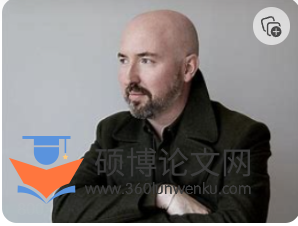本文是一篇英语论文,本文把自我建构的过程与拉康的三界理论和主体性研究联系起来分析了《舒吉•贝恩》中主人公的成长历程。这不仅让读者对小说的理解更深入,也让读者对自我建构背后的机制更加清晰明了。
Chapter One The Misrecognition of Self in the Imaginary Order
1.1 Shuggie’s Misrecognition of Self Through the Family
According to Lacan, the ego is based on an illusory image of wholeness and ownership, and it is the function of the ego that sustains this illusion of uniformity and ownership. In other words, the function of the ego is a function of misrecognition. He refuses to accept the truth of fragmentation and alienation.
The ego is the result of someone identifying with his or her own mirror image, so the ego is the product of the imaginary order. The imaginary order defines the process by which the ego is conceived and born--the mirror stage. The mirror stage is an arena in which the subject is permanently captured and mesmerized by his own image. The mirror stage describes the formation of the process of self-identification. The mirror stage occurs roughly from six to eighteen months. As the infant sees his own image in the mirror, the child for the first time begins to realize that his body has a holistic form. The baby can also control the movement of this image through the movement of his body and experience pleasure as a result. This sense of wholeness and control, however, is in stark contrast to the child‟s experience of his or her own body. The child may feel that his body is divided, fragmented and not yet unified because he does not have sufficient control over his body, but this image provides the child with a sense of unity and wholeness.

英语论文怎么写
.........................
1.2 Shuggie’s Misrecognition of Self Through the Little Other
Lacan regards the confirmation of the mirror self as a kind of visual gestalt construction that guarantees its own continuity and unity of mind and body as a whole. This gestalt symbolizes the mental permanence of the “I”. At the same time, it prefigures one‟s alienating destination. “It is still pregnant with the correspondences that unite the „I‟ with the statue in which man projects himself, with the phantoms that dominate him, or with the automaton in which, in an ambiguous relation, the world of his own making tends to find completion” (Lacan, 2005: 2). This is a classic expression. When the infant, who is still in a non-unity state that cannot be delimit from the external reality, sees a relatively stable image of himself in the mirror, he mistakenly identifies this “other” that is not his own as “self”.
That is to say, the self that children in the mirror stage see in the mirror is the formation of the self in children‟s psychology. It also can be said that the self has successfully formed a complete self through the help of mirror. But this complete self is not the self of the real world, but a part of the real self, a part of the imagination. And its essence is still a shield for the homogenization of the real self. If an individual wants to develop into a true self-subject with a complete sense of self, the process of his or her identity construction must be established through the mirror image of others, that is, through the interaction with others around it. In this period of Shuggie‟s growth, the little other also plays an important role. In addition to the influence of parents on him, his grandparents, older brother and sister also affect him deeply.
...........................
Chapter Two The Split Between Self and Subject in the Symbolic Order
2.1 Shuggie’s Split Between Self and Subject Through the Name of the Father
The end of the mirror stage is a necessary stage for the growth of the person, and only when the person is freed from the narcissistic imagination can the intervention of symbolic order and language be possible. The symbolic order and language are the cultural system, which plays an important role in the development of the person:
It is this moment that decisively tips the whole of human knowledge into mediatization through the desire of the other, constitutes its objects in an abstract equivalence by the co-operation of others, and turns the I into that apparatus for which every instinctual thrust constitutes a danger, even though it should correspond to a natural maturation--the very normalization of this maturation being henceforth dependent, in man, on a cultural mediation as exemplified, in the case of the sexual object, by the Oedipus complex. (Lacan, 2005: 94-95)
........................
2.2 Shuggie’s Split Between Self and Subject Through the Big Other
When the signifier appears in the realm of the big Other, the subject is revealed. The big Other precedes the subject. As the big Other in the place of language, the speaking big Other precedes the subject and speaks about the subject before its birth. Therefore, the big Other is the first cause for the subject. The subject is not an entity and it is an effect of the signifier. That is to say, the subject is represented by the signifier, and there is no subject until the signifier appears. But the absence of a subject does not mean there is nothing, because there is still a living being. But the living being becomes a subject only if a signifier represents him. Therefore, the subject is an empty space until the signifier appears. What‟s more, the big Other is not just a signifier but also an eternal and unchanging law that forms the basis of meaningful communication and understanding. In Lacan‟s theoretical framework, individuals in the pursuit of desires constantly interact with of the big Other in the symbolic order. They also attempt to satisfy their desires through symbols, but this process is always fraught with frustration, as the big Other can never fully satisfy the individual‟s desires.
Essentially, human beings are social animals. Individuals who live solitary by nature are either unworthy of our attention or not human beings. Society, in essence, exists before the individuals. Those who cannot live a public life or those who can self-sustain and do not need to live a public life, are “either beasts or gods” (Lord 44). Shuggie is thrown into public life in society at birth.
........................
Chapter Three The Pursuit of Self-identity in the Real Order ............................... 53
3.1 Shuggie‟s Pursuit of Self-identity Through Agnes‟s Death.............................. 53
3.2 Shuggie‟s Pursuit of Self-identity Through Leanne ............................... 61
Conclusion ............................ 67
Chapter Three The Pursuit of Self-identity in the Real Order
3.1 Shuggie’s Pursuit of Self-identity Through Agnes’s Death
Among the three orders, the real order is the most obscure and difficult to understand. The real order refers to the domains that cannot be known. As we have established from the previous discussion, language is the medium through which we come to know things. In other words, we never know anything directly. In this sense, the real order is the world before the division imposed by language. Actually, the real order is a highly paradoxical concept. The “reality” is constituted by symbolic signs and the process of signification while the real order is a void that both sustains and undermines our reality. In the practice of psychoanalysis, the real order is closely related to the subject‟s trauma and desire. It represents the unutterable and unspeakable truth that cannot be symbolized and it is the part that the subject cannot integrate when encountering trauma. Lacan considers the real order to be the source of desire and the object “a” that can never be fully satisfied. This object does not actually exist. It is the lack of desire and the goal that the subject continuously seeks in the pursuit of desire. The characteristic of the real order makes it an eternal pursuit, an endpoint that can never be reached.

英语论文参考
..........................
Conclusion
Shuggie Bain is a novel by Douglas Stuart that tells the story of the protagonist Shuggie Bain‟s difficult life in Glasgow in the 1980s. Shuggie is a young boy whose mother, Agnes, is an alcoholic, forcing him to take on the responsibility of caring for her and himself at a very young age. The novel, seen through Shuggie‟s eyes, portrays the life of a broken family and how Shuggie seeks self-identity in the process of self-construction and growth amidst poverty, neglect and loneliness. Shuggie‟s story is one of resilience, hope, and love. His life is filled with challenges, including poverty, domestic violence and social prejudice. Nevertheless, Shuggie demonstrates extraordinary tenacity and deep affection for his mother. In the novel, Shuggie‟s relationship with Leanne is also an important plotline. Leanne‟s presence brings a glimmer of light into Shuggie‟s life. And their friendship and mutual support help Shuggie take a significant step on the path to self-identity. Through his interactions with Leanne, Shuggie learns to maintain his sense of self in adversity, reflecting his gradual approach to the real order or his true self.
Self-construction is a psychological term that refers to how individuals shape and define their personalities, identities, and self-images through their experiences, cognition, emotions, and behaviors. This process involves understanding one‟s place in the world and how to interact with others and society. Self-construction is an ongoing, dynamic process influenced by personal growth experiences, cultural background, social environment, and individual choices. In the field of psychology, self-construction is closely related to self-identity, but it focuses more on how individuals actively shape and adjust their self-concept. This includes individuals‟ understanding of their abilities, values, beliefs, and goals, as well as how these perceptions influence their actions and decisions.
reference(omitted)
